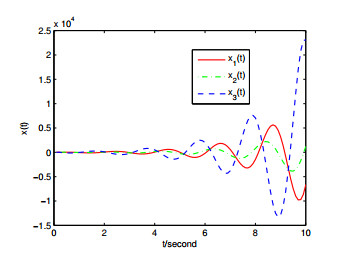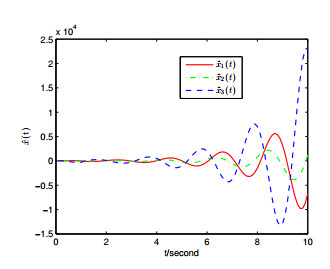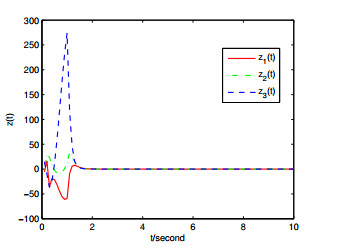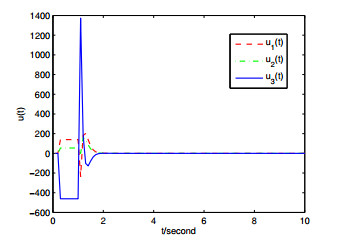1.
Introduction
It is known to all that Lurie systems consist of a linear dynamical system and a nonlinear part with the sector bounded constrains, which can be used to model many nonlinear dynamical systems such as Chua's circuit [1], Hopfield neural networks [2], cellular neural networks [3] and hyperchaotic attractors [4], and so on. Thus, the Lurie systems have attracted much attention of researchers in the field of physical and natural science. For example, by using an extended integral inequality, the convex combination theorem and S-procedure, Tang et al. investigated the cluster synchronization of complex dynamical networks consisting of identical or nonidentical Lurie systems and designed some adaptive updating laws in [5]. Qin et al. investigated the problem of the global exponential stability of a class of uncertain neural networks with discontinuous Lurie-type activation and mixed delays and presented some stability conditions by using the Leray-Schauder alternative theorem in [6].
In recent years, master-slave synchronization has attracted some researchers attention for its broad applications and there exist lots of literatures such as [7,8,9,10,11,12,13,14]. Master-slave synchronization means that the state of master system follows with the state of slave system along with the time development. In some practical plants, because the state of the master systems can not be measured directly for technical limitations or too cost, we can use its measurement output to design a slave system that the structure is same with the master system. So, one can use the state of slave system to replace the state of master system. Viewed from the used methods of solving this problem, there include adaptive control [7], PID control [9], output feedback control [10], impulsive control [11,12], and so on. There exist many work to study the master-slave synchronization of the Lurie systems so far. For example, Chen et al. investigated the master-slave synchronization of chaotic Lurie systems with sampled-data control based on a novel construction of piecewise differentiable Lyapunov functionals in [15]. By using the Lyapunov stability theory, Ji et al. considered the synchronization problem for Lurie systems with sector and slope restricted nonlinearities in [16]. For the master-slave Lurie systems with constant time delay, Guo et al. presented some synchronization criteria and designed a PD controller by using the integral inequality method in [17].
In addition, event-triggered control, as one of the effective control methods, has been deeply studied. Event-triggered controller is updated only if some predefined triggering criteria are activated. Compared with the time-triggered controller, the event-triggered controller can reduce the number of the sampling and decrease the computation complexity. Some related works can be found in [18,19,20,21,22,23,24,25,26]. For instance, Su et al. studied the problem of sliding mode control for discrete-time switched systems via an event-triggered strategy by using a time-delay system design method in [18]. By using the multiple Lyapunov functional method, Xiao et al. considered the event-triggered control problem for continuous-time switched linear systems in [19]. Liu et al. discussed the event-triggered synchronization in fixed time for semi-Markov switching dynamical complex networks with multiple weights and discontinuous nonlinearity by applying Lyapunov functional method and inequality analysis technique in [21]. In [22], Wang et al. investigated the Lyapunov stability for general nonlinear systems by means of the event-triggered impulsive control by using the impulsive control theory.
Motivated by the above discussion, in this paper, we intend to investigate the master-slave synchronization of Lurie systems based on the event-triggered control. The main contributions are as follows: (1) The considered master-slave systems are the Lurie systems, and the related results by using the event-triggered control are less. (2) Provide a predefined event-triggering condition and prove that this condition is not commonplace. (3) Some synchronization control criteria are presented. Moreover, the control gains can be easily found in terms of linear matrix inequalities.
The rest of this paper is organized as follows. In section 2, model description and preliminary results are presented. In section 3, The event-triggered conditions and feasibility are derived. In section 4, a numerical example is provided to illustrate the effectiveness of the obtained method. Finally, this paper is ended with a conclusion in section 5.
Throughout this paper, the following notations are used. Rn and Rn×m, respectively, denote the n-dimensional Euclidean space and the set of n×m real matrices. For a n-dimensional vector x=(x1,x2,...,xn)T∈Rn, ||x||=√∑ni=1x2i denotes its norms. The notation X≥Y(respectively, X>Y), where X,Y are symmetric matrices, means that X−Y is a symmetric semi-definite matrix(respectively, positive definite matrix). For a given matrix A∈Rn×n, AT denotes its transpose. λmax(A) and λmin(A) denote its maximum and minimum eigenvalues, respectively, whose norm is defined as ||A||=√λmax(ATA).
2.
Problem formulation
In this paper, we consider the following master-slave systems composed of Lurie systems
and
where x(t)=(x1(t),x2(t),...,xn(t))T and ˆx(t)=(ˆx1(t),ˆx2(t),...,ˆxn(t))T denote the state vectors, respectively. A∈Rn×n,B∈Rn×n,C∈Rn×m,D∈Rm×n are some known constant real matrices. σ(⋅)=(σ1(⋅),σ2(⋅),...,σm(⋅))T:Rm→Rm is a nonlinear function. The initial conditions φ(t)∈Rn and ψ(t)∈Rn are continuous functions. u(t)∈Rn is the control input to be designed. τ>0 is a known constant and denotes the transmission time delay.
Definition 1. Master system (2.1) and slave system (2.2) are said to be asymptotic synchronization if
for any initial conditions.
In what follows, we intend to design the following state feedback controller
such that master system (2.1) synchronizes with slave system (2.2), where K∈Rn×n is the control gain to be determined, t0,t1,⋯,tk,⋯ are the sampling time and limk→+∞tk=+∞. From which we know that the control signal holds constant by a zero-order hold (ZOH) until the next sampling time. This kind of control scheme is usually called event-triggered control. Different with some common state feedback controller, which needs not be updated at each sampling instant.
Remark 1. Event-triggered controller (2.3) is a ZOH and does not compute and transmit the control information at each sampling instant, which can reduce the computation complexity and decrease the burden of transmission data.
Let z(t)=x(t)−ˆx(t) and e(t)=z(t)−z(tk), then one gets the error system
where h(z(t))=σ(Dx(t))−σ(Dˆx(t)) and hi(z(t))=σi(dTix(t))−σi(dTiˆx(t)), dTi is the ith row of matrix D.
In order to establish our main results, the following assumptions and lemmas are necessary.
Assumption 1. Assume that each component of the nonlinear function σ(⋅) belongs to the sector bound [0,η], i. e.,
for any ξ1,ξ2∈R, where η>0 is a known positive constant. In fact, this condition is similar to literature[26].
From Assumption 1, one gets
where d=√∑mi=1||di||2=√∑mi=1∑nj=1d2ij, dij are the element of matrix D=(dij)m×n.
Lemma 1.[27] For any symmetric positive matrix W∈Rn×n and scalar τ>0, there is
3.
Main results
This section will present some event-triggered conditions under which master system (2.1) and slave system (2.2) achieve synchronization, and further shows that the length of triggered interval is bigger than zero.
Theorem 1. Under Assumption 1 and the action of event-triggered controller (2.3), if there exist symmetric positive matrices P∈Rn×n, Q∈Rn×n, R∈Rn×n, matrix K∈Rn×n and positive constants β>0,γ>0 such that
where
then master system (2.1) synchronizes with slave system (2.2). In addition, controller (2.3) is updated when
with α∈[0,1).
Proof. Choose the Lyapunov functional as
Then the derivative of V(t) with respect to the trajectories of error system (2.4) is
It is known that there exists a positive scalar γ>0 such that
By Lemma 1 and (3.1), one gets
where ξ(t)=[zT(t),zT(t−τ),hT(z(t)),eT(t)KT]T and ||Ke(t)||≤√α||z(t)||. From the Lyapunov stability theory, we know that limt→∞z(t)=0. Thus, master system (2.1) and slave system (2.2) are synchronized.
Remark 2. In fact, system (2.4) asymptotically converges to zero only if condition (3.1) holds when t∈[tk,tk+1). If inequality (3.1) does not hold, then we will control it by using the information of next sampling instant. So we can take the triggering event as
It is noticed that (3.1) is a nonlinear inequality on the variables, and we can obtain the following linear matrix inequality by variable transformation.
Theorem 2. Under Assumption 1 and the action of event-triggered controller (2.3), if there exist symmetric positive matrices Q∈Rn×n, R∈Rn×n, matrix W∈Rn×n and positive constants β>0,γ such that
where
then master system (2.1) synchronizes with slave system (2.2). In addition, controller (2.3) is updated when
with α∈[0,1), K=R−1W.
Proof. From (3.1) and letting P=R, one gets
where ˆΘ is the same with Θ except ˆΘ11=P(A−K)+(A−K)TP+Q−R+βIn. Letting RK=W and applying the Schur complement lemma, we know that (3.8) is equivalent with (3.7). The proof is completed.
Remark 3. In Theorem 1, because PK and RK all include variable K, it is difficult to depart them away. Thus we take P=R, which increases the conservatism of the results.
Theorem 3. For α∈[0,1), the length of triggered control interval [tk,tk+1) is not commonplace for any k=0,1,⋯. That is, there must exist a positive scalar δ>0 such that mink≥0{tk+1−tk}≥δ.
Proof. In order to show this result, we calculate
Noting that error system (2.4) is convergence, so its state is bounded for t>0. Without loss of generality, we suppose that there exists a nonnegative constant γ≥0 such that supt≥0{||z(t−τ)||||z(t)||}≤γ. Thus,
where μ=||A−K||+γ||B||+dη||C||. Letting y(t)=||Ke(t)||||z(t)||+μ+||K||2, and in view of
there is
It follows from the compare theory of the differential equation that
where we use the fact e(tk)=0 and y(tk)=μ+||K||2. As
there is
Since α∈[0,1), one gets t>tk. Which shows that the length of the sampling interval [tk,tk+1) is bigger than zero for k=0,1,2,....
4.
A numerical example
Example 1. Take the following Chua circuits [28] as master system
where σ(x1(t))=12(m1−m0)(|x1(t)+1|−|x1(t)−1|), m0=−17,m1=27,a=9,b=14.286,c=0.1, τ=2. Writing
σ(x(t))=(0.5(|x1(t)+1|−|x1(t)−1|),0,0)T, then system (4.1) can be rewritten as the form of system (2.1). Then its phase diagram is shown in Figure 1 and appears the scroll attractors.
After computation, one gets the feasible solutions of inequality (3.7) as
From Theorem 2, we know that master-slave systems (2.1) and (2.2) with the given parameters can synchronize with each other. Taking the initial conditions x(0)=(−41.5,34,−44.5)T and ˆx(0)=(−6,10.5,−8)T respectively, then the state trajectories of master-slave systems (2.1) and (2.2), update laws (2.3) and error system (2.4) are shown in Figures 2–5. In particular, Figure 4 shows that master-slave systems (2.1) and (2.2) synchronizes well.
5.
Conclusions
This paper has investigated the master-slave synchronization of Lurie systems with time delay via event-triggered control scheme. We have obtained the synchronization conditions and the computation method of the control gain. Moreover, we have proved that the presented event-trigged controller is not commonplace. A numerical example has shown that the proposed method is right.
Conflict of interest
The authors declare that they have no conflicts of interest.
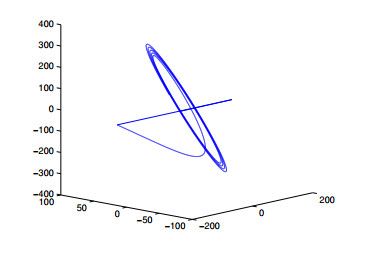









 DownLoad:
DownLoad:
